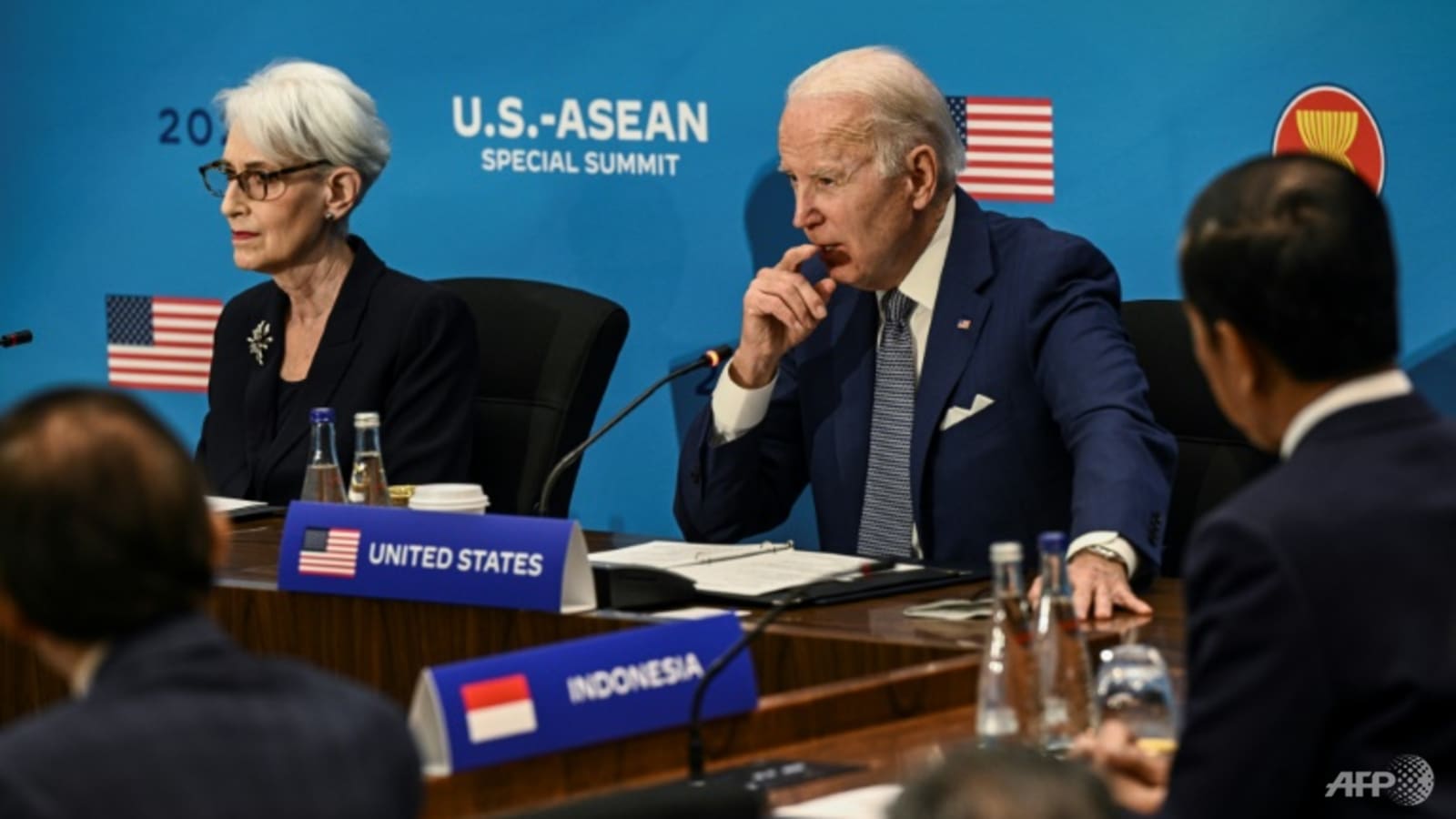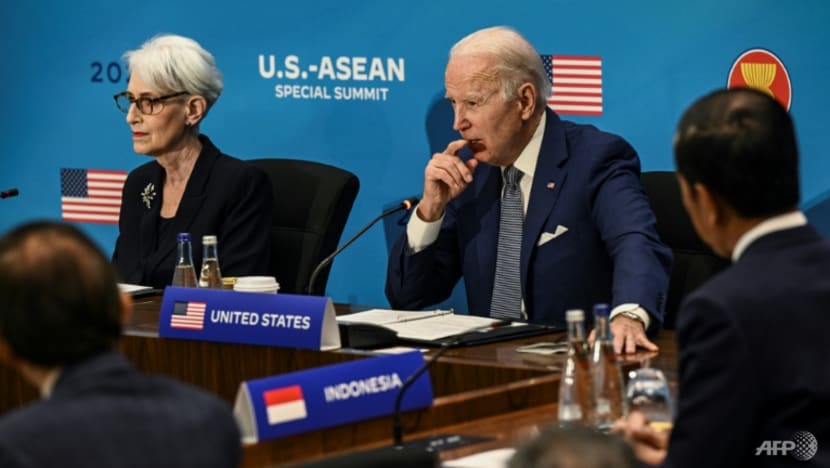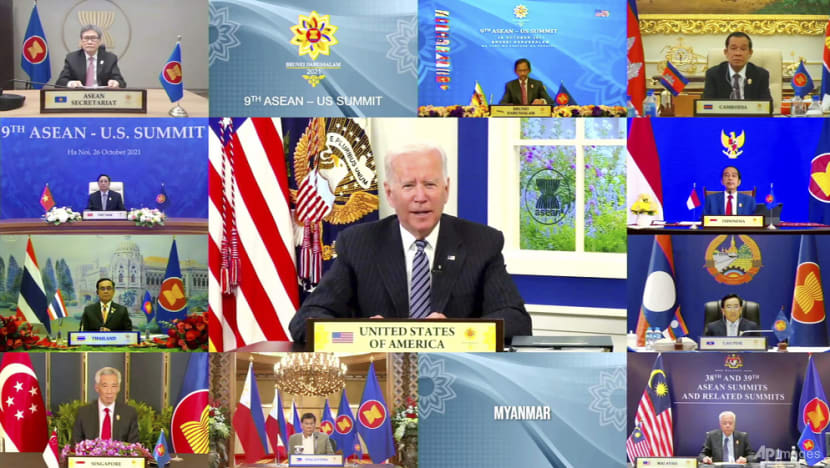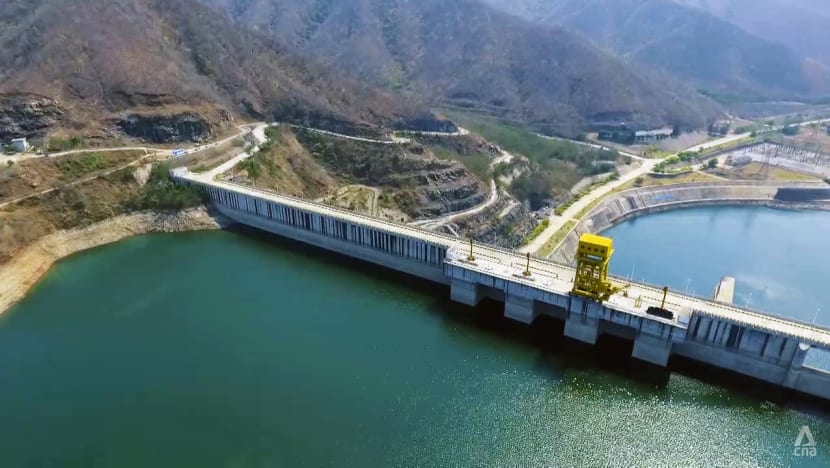
While the United States is an irreplaceable element of any strategic balance in Southeast Asia, diplomatic relationships could be in jeopardy if it pushes the ideological dimensions of its rivalry with China too insistently, says former Singapore senior diplomat Bilahari Kausikan.

US President Joe Biden participates in the US-ASEAN Special Summit at the US State Department. (Photo: AFP/Brendan SMIALOWSKI)
SINGAPORE: After years of relative neglect under former president Donald Trump, the United States is once more seeking to strengthen its ties with the governments of Southeast Asia. An in-person summit with the Association of Southeast Asian Nations was held last week in Washington, as US President Joe Biden sought to better position his country in the wider geopolitical competition with China.
The summit’s significance lies in its timing; it was held as war rages in Ukraine, demonstrating that the United States has not lost its focus on the Indo-Pacific. But even though US officials ritually invoke the importance and “centrality” of ASEAN, the regional organisation is not as central to US policy as many once thought it to be.
Just before Trump left office in January 2021, his administration hastily declassified and released a secret 2018 cabinet memorandum entitled “US Strategic Framework for the Indo-Pacific” that outlined US interests in the region and the means by which Washington intended to secure them.
The Biden administration’s equivalent paper, issued this past February, overlapped considerably with that of its predecessor. That consistency in stated policy contrasts with the fact that, in practice, the Biden administration’s approach to the region has so far been rather different than that of Trump, who never displayed much interest in Southeast Asia and indeed could barely conceal his disinterest in regional meetings, when he deigned to attend them at all.
Trump’s indifference stemmed less from a flawed strategy and more from the fact that he was erratic and undisciplined. The Biden administration marks a welcome return to normalcy by merely doing what it is supposed to do.
ASEAN NOT A US PRIORITY
High-ranking US officials have met with Southeast Asian leaders and toured the region. Biden attended a joint virtual summit with ASEAN in October 2021, the first US-ASEAN summit since 2016. US Secretary of Defense Lloyd Austin visited Singapore, Vietnam and the Philippines in July 2021 and US Vice President Kamala Harris visited Singapore and Vietnam in August 2021.
US Secretary of Commerce Gina Raimondo visited Singapore and Malaysia in November, and US Secretary of State Antony Blinken visited Malaysia and Indonesia in December 2021.
This flurry of visits and meetings was refreshing after the Trump administration’s fitful and reluctant engagement with Southeast Asia. But in common with its predecessor, the Biden administration’s approach to the region does not necessarily prioritise ASEAN, Southeast Asia’s only region-wide organisation.
Biden has focused on building up the security partnership between Australia, India, Japan and the United States, known as the Quad, as well as the announcement of strong new ties with Australia and the United Kingdom under the AUKUS security pact.
Within Southeast Asia, the emphasis has been as much on – and perhaps more so – bilateral relationships as on working with ASEAN.
This has left the organisation uncertain about how central it really is in American eyes, an insecurity enhanced by Biden’s not having bothered to nominate an ambassador to ASEAN until recently. The post had been vacant since former US president Barack Obama’s last appointee left the position in 2017.
More important, just practising diplomacy as usual will not win the United States many prizes in its strategic competition with China. If the Biden administration is to really build on its promising start in Southeast Asia, it must embrace two realities of the region.
The focus in Washington on maritime competition with China misses the importance of the land; without greater US engagement, Beijing’s dam-building along the upper reaches of the Mekong River gives it a potential stranglehold over the five ASEAN members through which the river runs.
Relationships with capitals in the region could also be in jeopardy if the Biden administration pushes the ideological dimensions of its rivalry with China too insistently.

US STILL INDISPENSABLE TO THE REGION
When it became clear that Biden would win the presidency, many US partners in Asia, including in Southeast Asia, were concerned that the new president, like Obama in his second term, would be reluctant to use hard power to counter Chinese assertiveness. These fears about the new administration have not materialised.
Early actions in the Taiwan Strait and in the South China Sea, where US warships have asserted the right to freedom of navigation in the face of extravagant Chinese maritime claims and attempts at intimidation, provided reassurance that the Biden administration would not repeat Obama’s fundamental mistake of believing that eloquent speeches could substitute for the exercise of military muscle.
Southeast Asian countries generally welcomed Biden’s bold correction of a 20-year-old error in Afghanistan to refocus on the more strategically important Indo-Pacific, even if the botched evacuation evoked echoes of the United States’ withdrawal from Vietnam and reawakened old concerns about the reliability of US commitments.
Notwithstanding the upcoming summit, Ukraine has since absorbed most of the day-to-day attention of US policymakers. This is understandable, as a relatively peaceful and stable Southeast Asia is always going to seem less urgent to Washington when fires are burning elsewhere.
Still, the war in Ukraine has also underscored the importance of regional balances and the vital role that the United States plays in maintaining such balances. Singapore came to this conclusion decades ago. Even if they are not prepared to say so publicly, other Southeast Asian countries, too, now better understand that they have no option but to rely on US power to maintain a balance in the region.
Aggressive Chinese behaviour in the South China Sea and elsewhere in the Indo-Pacific has underscored the reality that the United States is an irreplaceable element of any strategic balance in the wider region.
The United States’ indispensability renders concerns about its reliability moot. Vietnam has been cautiously establishing defence relations with the United States.
Despite his anti-American bluster, outgoing Philippines President Rodrigo Duterte renewed, in 2021, the Philippines’ Visiting Forces Agreement, which provides the legal basis for the presence of US forces in the Philippines. He also pursued enhanced relations with Australia and Japan, the principal US allies in the region.
Indonesian and Malaysian diplomats might have criticised AUKUS and are wary about the Quad, but their defence establishments quietly hold different views and both countries conducted high-profile military exercises with the United States in 2021.
Singapore’s Yusof Ishak Institute of Southeast Asian Studies (ISEAS) 2022 State of Southeast Asia Survey, a survey of elite opinion in the ten ASEAN member states, showed that 63 per cent of those surveyed welcomed US regional, political and strategic influence and 52 per cent trusted the United States to do the right thing to contribute to global peace, security, prosperity and governance. Only 19 per cent said the same about China.
The United States was the second most trusted major power among respondents in Southeast Asia, after Japan. The European Union was third. As in previous surveys, China remained the least trusted power, with 58 per cent professing distrust of Beijing.
That doesn’t mean that the United States can rest on its laurels. Southeast Asians recognise the importance of China to the region’s future. In 2022, almost 77 per cent of those surveyed by ISEAS considered China the most influential economic power in Southeast Asia, compared to a meagre ten per cent who thought that the United States was most influential.
Nevertheless, around 76 per cent were worried about China’s political and strategic influence. When asked which they would choose if ASEAN were forced to align itself with either China or the United States, 57 per cent of respondents chose the United States and 43 per cent chose China.
There is clearly an opening for the Biden administration to improve the US position in Southeast Asia if it chooses to take it.
TRADE IS STRATEGY
The most obvious gap in US policy in the Indo-Pacific is economic. Despite China’s growing economic weight in Southeast Asia, the United States remains an important bilateral economic partner for most ASEAN members and a preferred source for quality non-infrastructure investment, particularly at the technologically higher end of the value chain.
Washington needs to leverage this advantage through more proactive and coordinated public-private efforts to promote US trade and investment. That cannot be left to ad-hoc efforts by the private sector or to market forces.
What’s missing is a multilateral economic programme. This year, the Regional Comprehensive Economic Partnership (RCEP) – an ASEAN initiative intended to rationalise its existing free trade agreements with Australia, China, Japan, South Korea and New Zealand – came into force.
Since the United States does not have a free trade agreement with ASEAN, it does not qualify to join the RCEP. Trump’s withdrawal in 2017 from the Trans-Pacific Partnership has proved to be a huge mistake; the move left the United States an outlier in a region where trade is strategy.
There is little prospect of the United States joining the TPP’s successor, the Comprehensive and Progressive Agreement for Trans-Pacific Partnership (CPTPP). Recognising this political reality, the Biden administration has proposed an Indo-Pacific Economic Framework. But this framework is only just that – an outline whose contents have yet to be filled in.
At present, it is a motley list of issues – facilitating trade, making supply chains more resilient, developing clean energy, investing in infrastructure, and shaping standards for technology, labour and the digital economy – that need to be fleshed out into practical policies.
Still, the framework at least recognises that there is a missing economic piece to be filled. But even with more detail, these proposals are not substitutes for US involvement in a multilateral deal of the scale and scope of the CPTPP.
ASEAN countries understand that the domestic politics of trade in the United States are complex. But the Biden administration should not foreclose any possibility of the United States eventually joining the CPTPP. China has applied to join the pact.
Not all its members are eager to admit China, but those with reservations will find it easier to delay or block China if US re-entry seems plausible; they can then argue that China and the United States should be admitted together. The Biden administration should try to turn the bipartisan consensus on competition with China to its advantage by systematically recasting the CPTPP in a strategic, and not just economic, light.
DAMS AND DEMOCRACY
In its second year, the Biden administration should keep two points in mind when crafting policy on Southeast Asia. First, the land is as important as the sea.
The dams that China has and continues to construct on the upper reaches of the Mekong River, which runs through the five mainland ASEAN member states, not only pose an immense ecological hazard but, together with north-south railways and highways, could entrench a dependence on Beijing that would reshape the strategic geography of Southeast Asia and could turn the boundaries between southwestern China and Southeast Asia into just lines on maps.
In 2009, the Obama administration initiated the Lower Mekong Initiative, which promised a new US interest in and emphasis on the Mekong region that could balance China’s presence there. In Obama’s second term, however, the administration seemed to lose interest in its own project, perhaps because it failed to understand its strategic importance.
The initiative accomplished little. It remains on the table but was overshadowed by China’s Lanchang-Mekong Cooperation Initiative (Lanchang is what China calls the headwaters of the Mekong in its territory).

It was not until late in 2020 that the Trump administration attempted to resurrect the initiative, rebranding it as the US-Mekong Partnership. The Biden administration is reportedly in the process of crystallising its own Mekong strategy. This will require an adequate allocation of resources, and consistent and high-level attention to succeed.
Mekong River issues have not received such attention from any previous administrations. The Mekong should be approached strategically in the broader context of US policy toward the Indo-Pacific, rather than piecemeal as a cluster of discrete technical or environmental issues, such as water management or climate change.
Second, Washington should avoid assuming that the United States’ decentralised democracy, in which distrust of the state is ingrained, is well understood in Southeast Asia, where a centralised government is the norm and a strong state is the aspiration – even if not always achieved in practice.
Ideological efforts in the vein of Biden’s Summit for Democracy, convened last December, risk alienating partners in Southeast Asia.
An event framed in terms of a supposedly universal contest between democracy and authoritarianism – both protean terms – would limit rather than expand support for Washington in the region. Malaysia, one of only three ASEAN members invited, declined to attend because it did not want to constrict its space to manoeuvre between China and the United States.
In general, Southeast Asians neither find all American values attractive nor all aspects of the Chinese system abhorrent. An approach that invokes a clash between democracy and autocracy will only risk alienating governments that do not look at the world in such absolutist and simplistic binary categories and have no wish to be forced into them.
The Biden administration would be ill-advised to pursue such ideological projects much further in Southeast Asia.
FROM THE CENTRE TO THE MARGINS
Since the end of the Vietnam War, the United States has been remarkably consistent and successful as an offshore balancer in Southeast Asia, maintaining the stability of the region and preventing it from falling under the sway of any hegemonic power. But times have changed.
Although China is a formidable competitor, it does not pose the same type of existential threat to the United States as the Soviet Union did during the Cold War. There is thus no longer any reason for Americans to bear any burden or pay any price to maintain order. ASEAN needs to better understand that US priorities now revolve around domestic issues more than in previous periods.
Washington, therefore, expects its partners and allies to carry more of the costs of maintaining order. ASEAN need not do everything the Biden administration may ask of it, but ASEAN urgently needs to discuss the parameters of what it is prepared to do – and equally important, what it is not prepared to do – with the United States to meet the common challenge of China.
In the absence of such clarity, the Biden administration will still politely call ASEAN “central” and attend its meetings, but Washington will in fact place much more emphasis on other partnerships, such as the Quad, and on particular bilateral relationships in Southeast Asia.
If the United States does not prioritise ASEAN, the diminished value of the regional body may cause China, too, to take it for granted, and it will lose leverage with both powers.
ASEAN and its members must better understand that strong relations with the United States are not an alternative to close relations with China but the necessary condition for such ties.
ASEAN imagines itself at the centre of the geopolitical competition in Southeast Asia, but it could well find itself on the margins, no longer a major actor in its own arena.
Bilahari Kausikan is former Permanent Secretary of the Ministry of Foreign Affairs of Singapore. Used with permission of Foreign Affairs, from “Threading the Needle in Southeast Asia” by Bilahari Kausikan, May 11, 2022; permission conveyed through Copyright Clearance Center, Inc.

